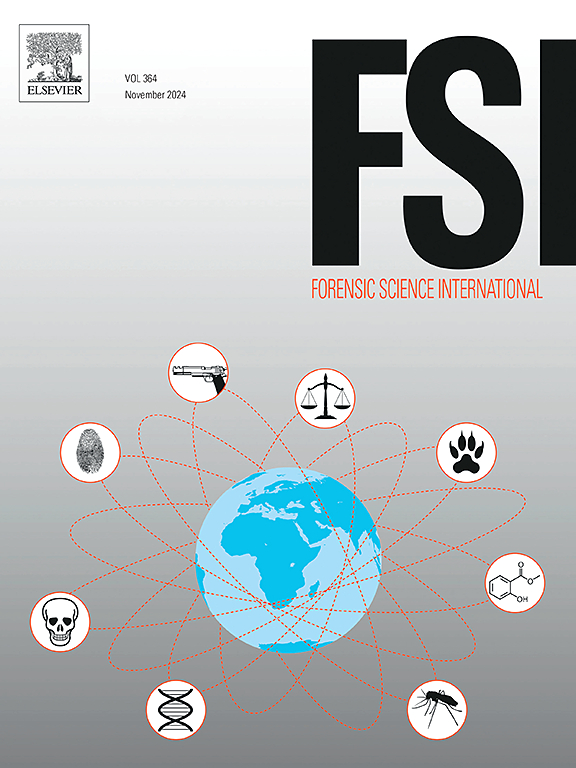Where did they go? The secondary (or higher) transfer of fibres from the home environment via daily wear
IF 2.2
3区 医学
Q1 MEDICINE, LEGAL
引用次数: 0
Abstract
When evaluating findings of trace-trace or trace-reference fibre comparisons that involve materials recovered from frequented environments, the probabilities of the secondary or higher transfer of these fibres need to be considered. Such a complex process of transfer can be roughly divided into three main parts, the acquisition of these fibres from the environment, followed by their persistence, and finally their re-transfer during the event of interest. The first step was explored in a previous article, while existing literature is already rich in data on fibre persistence. This study focuses on the third step of the process, particularly in assault scenarios. Two participants with known rates of fibre acquisition from their domicile environment were recruited to wear six shirts of two levels of surface roughness for eight hours in their home. These shirts (intermediates) were then collected and worn by combat athletes during an assault simulation by the volunteer playing the role of assailant. Meanwhile, the recipient wore a standardized blanked white t-shirt (recipients). Both sets of shirts were collected and analysed for target fibres identified from the home environment of the two participants. The quantity of these target fibres on each of these shirts were recorded and compared to the previously recorded acquisition rate of the two participants. Surface roughness was found to play a role in transfer, where a greater share of fibres was retained on the rougher intermediates. The class of fibre did not appear to influence the quantity transferred. Finally, the results were used to establish posterior models in four different scenarios that describe varying levels of information available to the forensic expert. These models could be roughly classified into count-based, which involved a direct modelling of the number of fibres transferred with a negative binomial-beta conjugate, and proportion-based, involving first the modelling of the acquisition using a negative binomial distribution, and the subsequent transfer with a binomial distribution, using the results of the first model as the size and a beta prior distribution to model the proportion transferred. Proportion-based models outperformed the count-based ones, and increasing levels of information permitted increased specificity towards each scenario.
他们去了哪里?通过日常穿着从家庭环境中转移的纤维的二次(或更高)转移
在评价涉及从频繁环境中回收的材料的痕量-痕量或痕量-参考纤维比较的结果时,需要考虑这些纤维的二次或更高转移的可能性。这种复杂的转移过程可以大致分为三个主要部分,从环境中获取这些纤维,然后是它们的持久性,最后是它们在感兴趣的事件中重新转移。第一步已在之前的文章中进行了探讨,而现有的文献中已经有丰富的关于纤维持久性的数据。本研究的重点是这个过程的第三步,特别是在攻击场景中。研究人员招募了两名从居住环境中获得纤维的已知比率的参与者,让他们在家中穿六件两种表面粗糙度的衬衫,持续八小时。这些衬衫(中间款式)被收集起来,由扮演攻击者的志愿者在模拟攻击时穿着。同时,接受者穿着一件标准的空白白色t恤(接受者)。收集并分析了两套衬衫,以确定从两名参与者的家庭环境中识别出的目标纤维。记录了每件衬衫上这些目标纤维的数量,并与之前记录的两位参与者的获取率进行了比较。表面粗糙度被发现在转移中起作用,其中更大份额的纤维保留在粗糙的中间体上。纤维的种类似乎不影响传输量。最后,结果被用于在四种不同的场景中建立后验模型,这些场景描述了法医专家可以获得的不同水平的信息。这些模型可以大致分为基于计数的模型和基于比例的模型,前者涉及使用负二项- β共轭对转移的纤维数量进行直接建模,后者涉及首先使用负二项分布对获取进行建模,然后使用二项分布进行后续转移,使用第一个模型的结果作为大小,并使用β先验分布对转移的比例进行建模。基于比例的模型优于基于计数的模型,并且增加的信息水平允许对每个场景增加特异性。
本文章由计算机程序翻译,如有差异,请以英文原文为准。
求助全文
约1分钟内获得全文
求助全文
来源期刊

Forensic science international
医学-医学:法
CiteScore
5.00
自引率
9.10%
发文量
285
审稿时长
49 days
期刊介绍:
Forensic Science International is the flagship journal in the prestigious Forensic Science International family, publishing the most innovative, cutting-edge, and influential contributions across the forensic sciences. Fields include: forensic pathology and histochemistry, chemistry, biochemistry and toxicology, biology, serology, odontology, psychiatry, anthropology, digital forensics, the physical sciences, firearms, and document examination, as well as investigations of value to public health in its broadest sense, and the important marginal area where science and medicine interact with the law.
The journal publishes:
Case Reports
Commentaries
Letters to the Editor
Original Research Papers (Regular Papers)
Rapid Communications
Review Articles
Technical Notes.
 求助内容:
求助内容: 应助结果提醒方式:
应助结果提醒方式:


